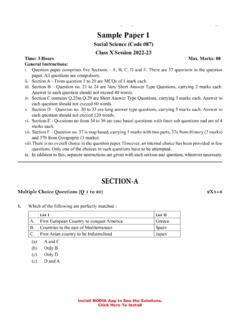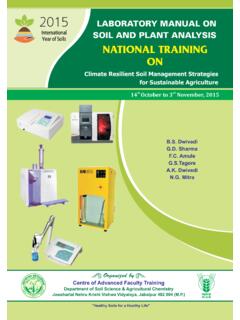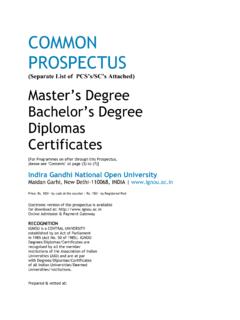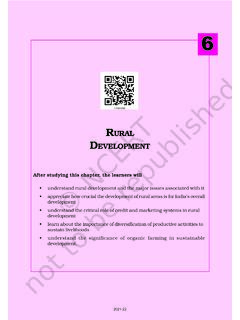Transcription of EUROPEAN WEED RESEARCH SOCIETY - EWRS
1 EUROPEAN weed RESEARCH SOCIETY Proceedings 6th EWRS Workshop on Physical and Cultural weed Control Lillehammer, Norway 8-10 March 2004 ii Proceedings were compiled and edited by: Daniel C. Cloutier weed Science Institute Box 222 Sainte-Anne-de-Bellevue (Qu bec) H9X 3R9 Canada Tel.: +1 514 630 4658 Fax: +1 514 695 2365 E-mail: Johan Ascard National Board of Agriculture Box 12 SE-230 53 Alnarp Sweden Tel.: + 46 40 41 52 87 Fax: + 46 40 46 07 82 E-mail: Scientific organisers Johan Ascard National Board of Agriculture Box 12 SE-230 53 Alnarp Sweden Tel.: + 46 40 41 52 87 Fax: + 46 40 46 07 82 E-mail: Daniel C. Cloutier weed Science Institute Box 222 Sainte-Anne-de-Bellevue (Qu bec) H9X 3R9 Canada Tel.: +1 514 630 4658 Fax: +1 514 695 2365 E-mail: Local organisers Jan Netland The Norwegian Crop RESEARCH Institute Plant Protection Centre H gskoleveien 7 N-1432 s Norway Tel.
2 : + 47 64 949315 Fax: + 47 64 949226 E-mail: Thomas Cottis Hedmark University College Bl stad N- 2322 Ridabu Norway Tel.: +47 62 54 16 16 Fax: +47 62 54 16 01 E-mail: Lars O. Brands ter The Norwegian Crop RESEARCH Institute Plant Protection Centre H gskoleveien 7 N-1432 s Norway Tel.: + 47 64 949492 Fax: + 47 64 949226 E-Mail: Corrected December 22, 2004 iiiTable of contentsCultural and physical weed control in organic farming weed control in organic pigeon bean (Vicia faba L. var. minor) throughoptimisation of crop spatial arrangementP. B rberi, P. Belloni, D. Cerrai, M. Fontanelli, Moonen & M. and tree row treatments in organic apple Brands ter & D. R en ..8 Development of a Decision Support System (DSS) for weed management in organicwinter wheat productionD. H. K. Davies & D. crops in cauliflower production: Implications for weeds, insects, beneficialarthropods and yieldW.
3 Hall, Brands ter, Breland & R. Meadow ..10 Designing crop rotations for organic plant production with low livestock density,combining weed control and nutrient L es, Brands ter & H. Riley ..11 The effects of different cover crops on weed control and yield in organic potato andtomato productionC. Mirabelli, R. Paolini, F. Faustini & F. weed control in organic spinach productionA. Peruzzi, M. Ginanni, M. Raffaelli & M. weed control in organic carrot productionA. Peruzzi, M. Raffaelli, M. Ginanni & M. compared to physical weed control measures in organically grown vegetablesH. Riley, L. O. Brands ter & G. Danielsberg ..39 Crop- weed interactions and cultural and physical weed results on the competitive ability of lentil (Lens culinaris) genotypesF. Faustini, R. Paolini, F. Saccardo, P. Crin & C. control technologies substantially alter the large-scale patterns of weed occurrence?
4 Hammond & of plant density and nitrogen fertilizer on the competitive ability of canola(Brassica napus L.) with weedsN. M. Hosseini, H. M. Alizadeh & H. M. Ahmadi ..44 The sensitivity of field peas (Pisum sativum L.) to weed harrowingH. L. F. Larsen & C. Andreasen ..55 Composition of weed floras in different agricultural management systems within theEuropean climatic gradientL. Radics, M. Glemnitz, J. Hoffmann & Gy. Czimber ..58 Computer model for simulating the long-term dynamics of annual Rasmussen & N. Holst ..69 Spot ploughing and population dynamics of weedsK. Shoji ..70 Population dynamics of weeds affected by time and type of T rresen ..82 Row distance as a key to efficient weed management in organic sugar & L. Bastiaans ..84 weed population dynamic by influence of crop rotation in 40-years periodL. weed control and design of an autonomous weeding robotT.
5 Bakker, van Asselt, J. Bontsema, J. M ller & G. van Straten ..94 The Swiss pocket knife concept for crop nursingR. Bauermeister, R. Total, Bleeker & Baumann ..95 Different strategies to improve mechanical intra-row weed control in bulb Bleeker, van der Schans & van der Weide ..97 Defining optimal conditions for weed harrowing in winter cereals on Papaver rhoeas other dicotyledoneous weedsA. Cirujeda & A. Taberner , , ..101 Crop growth stage susceptibility to rotary hoe cultivation in narrow row and wide rowsoyabean cropping Cloutier & Leblanc ..106vWater-jet cutting of potato tops some experiences from Sweden 2003F. Fogelberg ..111 Seed mapping of sugar beet to guide weeding Griepentrog & M. N rremark ..112 Achieving an optimal balance between machine vision capability and weed treatmenteffectiveness using competition Grundy, Onyango, K. Phelps, R.
6 Reader & the effectiveness and selectivity of mechanical Kurstjens ..114 The effect of blind harrowing using a flex-tine harrow or a rotary hoe combined withmanure amendment on bread wheat Leblanc & Cloutier .. 115 Lay-down working cart improves efficacy of hand weedingP. Leinonen & V. N weeder for cabbage and lettuce culturesP. Leinonen, A. Saastamoinen & J. for optimised weed harrowing in cereals including development ofexperimental equipment for weed harrowing trialsK. Mangerud, Brands ter, & J. Netland ..126 Analysis and definition of the close-to-crop area in relation to robotic weedingM. N rremark & Griepentrog ..127 Comparison of alternative interrow weeder steering Pullen & Cowell ..141 Are we making significant progress in mechanical weed control RESEARCH ? J. Rasmussen ..142 Techniques for green manure cutting: Energy requirement and ley recoveryM.
7 Tobiasson & G. Danielsberg ..150 Thermal weed soil in narrow strips for intra-row weed control in sugar beetD. Hansson & Svensson ..152A device to kill weed seeds captured during crop harvestingJ. Matthews, P. Harris & D. E. Miegel ..153viRecent results in the development of band steaming for intra-row weed controlB. Melander, J rgensen & L. Elsgaard ..154 weed seeds control by steam and substances in exothermic reactionA. Peruzzi, M. Borelli, M. Mazzoncini, M. Raffaelli, M. Ginanni & P. B for intra-row weed control in Globe ArtichokeM. Raffaelli , F. Filippi, A. Peruzzi & A. weed control by water steam in bulb , , , A. Stepanas & desinfection of soil by water , & weed control by steaming in vegetable cropsH. Sjursen & J. Netland ..179 Control of perennial ley with mid-summer bare fallow controls Elymus repensS. Kakriainen-Rouhiainen, J. V is nen, P.
8 Vanhala & T. L tj punctiformis as mycoherbicide on Cirsium arvenseS. S sensitivity of Cirsium arvense in relation to competition, and simulatedpremechanical , ter & ..184 Participatory organic weed management: Rumex spp. control - a farmer Turner & W. Bond ..185 Response of Sonchus arvensis to mechanical and cultural weed controlP. Vanhala, T. L tj nen & J. Salonen ..186 Effect of crop rotation and tillage on infestation of Cirsium arvense in organic farmingsystemsA. Verschwele & A. H usler ..187 Integrated weed weed control methods in winter and spring sown lentil (Lens culinaris) H. M. Alizadeh, H. K. Mojni & N. M. Hosseini ..196viiDestruction of Orobanche ramosa seeds with a new soil drench and control ofemergence by herbicidesJ. M. Matthews & D. E. Miegel..197 Information from other working interaction RESEARCH ; its link with physical and cultural weed controlL.
9 Bastiaans ..201 EWRS Working Group Education and Baumann, Cloutier & P. B rberi ..203 EWRS Working Group: Germination & Early Growth An overview of working groupactivities and opportunitiesA. physical and cultural weed control with biological methods prospects forintegrated non-chemical weed management strategiesP. E. Hatcher & B. Melander ..206 Methodology in physical weed for physical weed control RESEARCH : flame weeding, weed harrowing andintra-row cultivationP. Vanhala, D. Kurstjens, J. Ascard, A. Bertram, D. Cloutier, A. Mead, M. Raffaelli& J. Rasmussen ..2086th EWRS Workshop on Physical and Cultural weed Control 1 Lillehammer, Norway, 8-10 March 2004 Cultural and physical weed control in organic farming systems 6th EWRS Workshop on Physical and Cultural weed Control 2 Lillehammer, Norway, 8-10 March 2004 Cultural weed control in organic pigeon bean (Vicia faba L.)
10 Var. minor) through optimisation of crop spatial arrangement P. B rberi1, P. Belloni2, D. Cerrai1, M. Fontanelli3, Moonen1 & M. Raffaelli3 1 Land Lab, Scuola Superiore Sant'Anna, Pisa, Italy; 2 Centro Interdipartimentale di Ricerche Agro-ambientali E. Avanzi, University of Pisa, Italy; 3 Dipartimento di Agronomia e Gestione dell Agro-ecosistema, University of Pisa, Italy Introduction In low-external input systems, the effectiveness of direct weed control methods is very much dependent on the application of preventive and cultural measures aimed to reduce weed emergence in the field and increase crop competitiveness against weeds. This approach is especially important in organic agriculture (B rberi, 2002), where farmers must rely on non-chemical (usually mechanical) direct weed control methods. Pigeon bean (Vicia faba L. var. minor) is an important crop for organic systems in Central and Southern Italy because it has a high protein content and can be used either as a grain fodder or a green manure crop.









